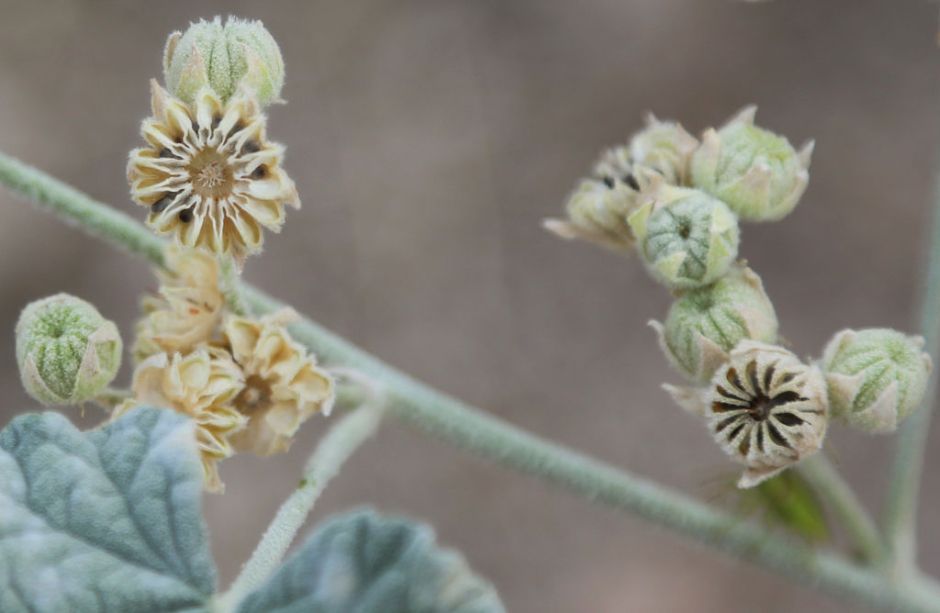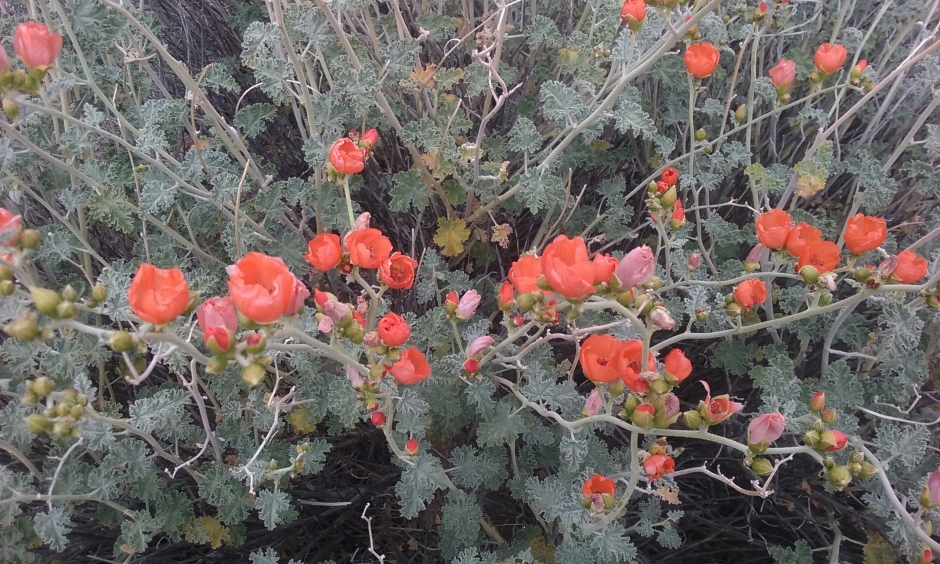Desert Mallow, also known as Globemallow or Apricot Mallow, is a small perennial shrub in the Malvaceae family with a large taproot thats blooming like crazy in the Mojave desert this spring. It’s found all throughout the Western interior along washes, slopes, roadsides, and trailsides in creosote bush scrub-lands, joshua tree woodlands, and pinyon-juniper woodlands. The entire plant has a distinctive light green color and is covered in small, star shaped hairs that give them a soft, fuzzy or wooly texture. Desert Mallow blooms abundantly in five petaled round orange flowers from it’s many erect stems during the spring and summer. It has palmate shaped leaves and produces small globe-like seed capsules, slightly similar in appearance to poppy pods. Globe mallow draws hummingbirds, native bees, and butterflies as pollinators and is drought tolerant, hardy to 20 degrees, and long-blooming, making it a good choice for native plant gardening. It’s easily propagated from seed and a little trickier from plant cuttings, and prefers well drained sandy soils. It is also a popular grazing food for bighorn sheep.
Parts Used
Root, leaves, flowers
Chemical Constituents
Mucilage, starch, pectin, flavonoids, phenolic acid, sucrose
Solvent
Water, oils, honey, alcohol
Medicinal Uses
Useful for the early stage of bronchitis and irritated throats, desert mallow soothes inflamed bronchial and throat passageways, making it a useful, abundant replacement for the over-harvested slippery elm. It acts as a demulcent, anti-inflammatory, and diuretic. It’s also useful to pacify unproductive coughs by easing the cough reflex. It also boosts the lungs immunity and resilience and works to stimulate the entire immune system. The plant also affects the urinary tract and bladder, soothing any inflamed tissues. For a urinary tract infection, Desert Mallow combines well with Manzanita Uva-ursi or Juniper. Externally, its mucilaginous qualities make a good poultice to ease swollen injuries, and pulling splinters and abscesses to the skins surface. The plant also has a restorative and soothing affect on the GI tract, useful for those with IBS or any kind of inflammatory bowel problems. Globe mallow teas work to soothe and restore the intestinal tract slowly over time. In general, it is a slowly acting but affective plant for chronic (not acute) heat (infection, irritation, inflammation) disorders in the body.
Traditional Uses
Traditionally, desert tribes used the roots of Desert Mallow to make a gooey poultice to soothe broken bones and swollen joints, as well as to treat upset stomachs. It combines well with oat-straw and rose petals as cooling, nourishing and soothing drink or wash for the body. The Hopi people traditionally used the plant to treat diarrhea and intestinal problems. The leaves can also be chopped and eaten as a cooked green or raw in salads, but do so at your own risk and be mindful of your tolerance to the potentially irritating fuzz on the leaves.
Flavor Profile and Energetics
Desert mallow is sweet, cooling, moist, and a yin tonic.
Dosage
As a tea, 2-3 tsp of dried herb per cup of water, strained through cloth – the fine hairs of the leaves can be irritating to the throat and mouth if left in the tea water. This can be taken 2-3 times a day. As a poultice, stir the plant in hot water until it’s thick and mucilaginous, scoop into a cloth and apply to the inflamed area as needed.
Combinations
For urinary tract infections, combine with uva-ursi and/or juniper. For combating winter dryness and coldness, a tea of mallow with ginger and cinnamon is perfect. For digestive health and achy guts, licorice, fennel, chamomile, and any alterative root (yellow dock root, dandelion root, burdock, etc). For external pulling poultices, bentonite clay, mullein, comfrey, and calendula are good additions.
Contraindications
None, but be sure to wash your hands after collecting or wear gloves, as the small hairs of the plants, soft at first, can become irritating to the skin and mucus membranes. Also, when using the leaves internally as a tea, strain them through a fine cloth multiple times to avoid drinking the small, potentially irritating hairs found abundantly on this plant.
Sources Used
5, 10, 16, 18, 20, 21

Globe-like seed capsules of the desert mallow, image from wikipedia.

Desert Mallow blooming in a wash in Joshua Tree, CA

You must be logged in to post a comment.